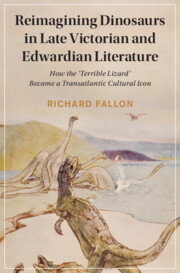 Reimagining Dinosaurs in Late Victorian and Edwardian Literature
Reimagining Dinosaurs in Late Victorian and Edwardian Literature Published online by Cambridge University Press: 28 October 2021
Chapter 4 shows dinosaurs’ link to concerns about secularisation and specialisation contributed to Arthur Conan Doyle’s famous romance The Lost World. It argues that the text can be understood in relation to Conan Doyle’s romantic approach to scientific knowledge, especially his strident anti-materialism and aversion to technical jargon. Examining archival material from New York Public Library’s Berg Collection, including the original manuscript, Fallon weaves the content of The Lost World together in surprising ways with Conan Doyle’s palaeontological forays, cryptozoological sightings, and interest in psychical research, showing that noting the differences between the US and UK serialised and book versions provides a more precise understanding of Conan Doyle’s intended romantic effects. In particular, Fallon emphasises the illustrations by Conan Doyle’s brother-in-law, Patrick Forbes. Alongside the text, these subtle and meticulously planned images make clear the author’s desire to convince readers that the world is full of unexplained wonders. As such, the British book edition in which Forbes’s images appear was, for Conan Doyle, the correct way to experience The Lost World.
To save this book to your Kindle, first ensure [email protected] is added to your Approved Personal Document E-mail List under your Personal Document Settings on the Manage Your Content and Devices page of your Amazon account. Then enter the ‘name’ part of your Kindle email address below. Find out more about saving to your Kindle.
Note you can select to save to either the @free.kindle.com or @kindle.com variations. ‘@free.kindle.com’ emails are free but can only be saved to your device when it is connected to wi-fi. ‘@kindle.com’ emails can be delivered even when you are not connected to wi-fi, but note that service fees apply.
Find out more about the Kindle Personal Document Service.
To save content items to your account, please confirm that you agree to abide by our usage policies. If this is the first time you use this feature, you will be asked to authorise Cambridge Core to connect with your account. Find out more about saving content to Dropbox.
To save content items to your account, please confirm that you agree to abide by our usage policies. If this is the first time you use this feature, you will be asked to authorise Cambridge Core to connect with your account. Find out more about saving content to Google Drive.